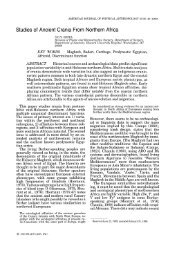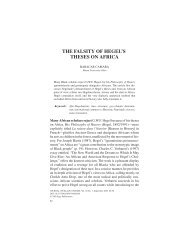Dutch Slavery and Slave Trade in the Indian Ocean
Dutch Slavery and Slave Trade in the Indian Ocean
Dutch Slavery and Slave Trade in the Indian Ocean
Create successful ePaper yourself
Turn your PDF publications into a flip-book with our unique Google optimized e-Paper software.
170 journal of world history, june 2003<br />
Fourth, despite politico-economic tensions between private settlers<br />
or burghers <strong>and</strong> VOC leadership, <strong>the</strong> basic fabric of colonial society<br />
was never seriously threatened. The exceptions to <strong>the</strong> rule at <strong>the</strong> Cape<br />
are <strong>the</strong> affair that led to <strong>the</strong> sack<strong>in</strong>g of Governor Willem Adriaen van<br />
der Stel <strong>in</strong> 1707, <strong>the</strong> Barbier rebellion of 1739, <strong>and</strong> <strong>the</strong> Patriot movement<br />
of <strong>the</strong> 1780s. 96 Though <strong>the</strong> Patriot movement had little impact<br />
on <strong>the</strong> citizenry of Batavia, dur<strong>in</strong>g <strong>the</strong> early history of <strong>the</strong> <strong>Dutch</strong> Asian<br />
headquarters a burgher movement lobbied for a city government, a<br />
Council of Aldermen (Schepenbank) of <strong>the</strong>ir own, which could not be<br />
manipulated by presid<strong>in</strong>g company officials. The letter, which <strong>the</strong>y<br />
sent <strong>in</strong> 1649 directly to <strong>the</strong> States General of <strong>the</strong> <strong>Dutch</strong> Republic<br />
(effectively bypass<strong>in</strong>g <strong>the</strong> high government <strong>in</strong> Batavia <strong>and</strong> <strong>the</strong> VOC<br />
directors <strong>in</strong> Amsterdam), <strong>in</strong> fact represented <strong>the</strong> culm<strong>in</strong>ation of a<br />
long-st<strong>and</strong><strong>in</strong>g feud between <strong>the</strong> burghers <strong>and</strong> company authorities,<br />
which had been ferment<strong>in</strong>g s<strong>in</strong>ce <strong>the</strong> found<strong>in</strong>g of Batavia <strong>in</strong> 1619. All<br />
requests from <strong>the</strong> Batavian citizenry, however, were brushed aside.<br />
They had to live under <strong>in</strong>stitutions, which were similar <strong>in</strong> name only<br />
to those back <strong>in</strong> Holl<strong>and</strong>, presided over by company officials, mostly<br />
members from <strong>the</strong> Council of <strong>the</strong> Indies. Henceforth, <strong>the</strong> free burghers<br />
lived subject to <strong>the</strong> whims of <strong>the</strong> successive governors general. 97<br />
Fifth, although slaves generally outnumbered <strong>the</strong> whites, <strong>the</strong><br />
slave/master ratio was never sufficiently tilted especially when <strong>in</strong>clud<strong>in</strong>g<br />
local Asian populations under <strong>Dutch</strong> jurisdiction. Unfortunately,<br />
exact numbers on <strong>the</strong> subject populations <strong>in</strong> <strong>Dutch</strong> conquests are lack<strong>in</strong>g,<br />
but <strong>the</strong>y acted as a significant corrective to <strong>the</strong> owner/slave ratio<br />
among <strong>the</strong> o<strong>the</strong>r groups. Sixth, despite “moments of creolization,” foreign-born<br />
slaves decisively outnumbered <strong>the</strong> creole slaves born locally<br />
<strong>in</strong>to servitude. These foreign-born slaves came from a variety of cultural<br />
backgrounds <strong>and</strong> hence were <strong>in</strong>ternally divided along ethnic, l<strong>in</strong>guistic,<br />
<strong>and</strong> religious l<strong>in</strong>es. The chance of a general slave revolt was<br />
pp. 135–36; Biew<strong>in</strong>ga, De Kaap de Goede Hoop, pp. 91–92; Shell, “<strong><strong>Slave</strong>ry</strong> at <strong>the</strong> Cape of<br />
Good Hope,” pp. 486, 491; Kieskamp, “De wereld <strong>in</strong> één l<strong>and</strong>,” pp. 81–82. There were<br />
some nutmeg gardens <strong>and</strong> w<strong>in</strong>e farms with more than 100 slaves, though <strong>the</strong>y were clearly<br />
<strong>the</strong> exception. In 1805, <strong>the</strong> largest s<strong>in</strong>gle number of slaves <strong>in</strong> an European household <strong>in</strong><br />
Batavia was 165. Sirks, “Het Recht om Huysselyk te Castyden,” p. 88.<br />
96 G. Schutte, “Company <strong>and</strong> Colonists at <strong>the</strong> Cape, 1652–1795,” <strong>in</strong> Elphick <strong>and</strong><br />
Giliomee, eds., The Shap<strong>in</strong>g of South African Society, pp. 303–15; Katzen, “White Settlers<br />
<strong>and</strong> <strong>the</strong> Orig<strong>in</strong>s of a New Society,” pp. 187–232; F. C. Dom<strong>in</strong>icus, Het Ontslag van Wilhem<br />
Adriaen van der Stel (Rotterdam 1928); C. Beyers, Die Kaapse Patriotte Gedurende die Laatste<br />
Kwart van die Agtiende eeu en die Voortlew<strong>in</strong>g van Hul Denkbeelde (Pretoria, 1967).<br />
97 N.P. van den Berg, Uit de Dagen der Compagnie: Geschiedkundige Schetsen (Amsterdam,<br />
1904), pp. 30–63; Blusse, Strange Company, pp. 24–25; De Haan, Oud-Batavia I, pp.<br />
112–14, 376–77; II, pp. 8–9.




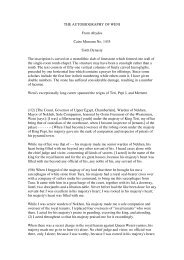
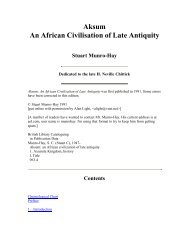
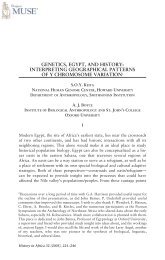

![The Negro trail blazers of California [microform] : a ... - Homestead](https://img.yumpu.com/32436613/1/174x260/the-negro-trail-blazers-of-california-microform-a-homestead.jpg?quality=85)

